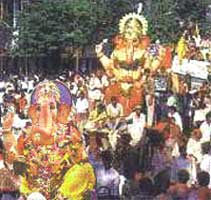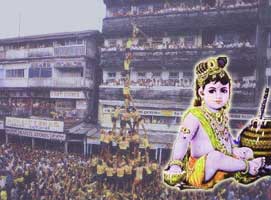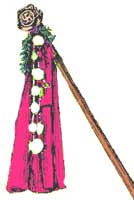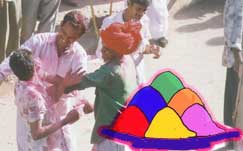|
|
|
Ganesh Festival
|
|
Ganesh Chaturthi is celebrated all over India, the festival is most extravagant at Mumbai and Pune. Traditionally a household affair, it was converted into a public celebration a century ago when the freedom fighter Lokmanya Tilak, used it to unite the masses for the freedom struggle. Ganesh (or Ganpati as he is often affectionately called) is, after all, the remover of obstacles. At the end of 11 day festival, plaster and clay images of Ganesh, some of them 6m high, are taken from home to street mandals (shrines) and carried in huge processions to be immersed in the river.
Pic By : Amit Shah Pune |

|
|
|
Gokul Ashtami |
 |
Gokul Ashtami also known as Janmashtami is the day when birth of Lord krishna is celebrated. Most devotees fast till midnight and when the birth of Lord Krishna is announced, they eat a festive preparation of rice, butter, yogurt, puris and potatoes. According to Hindu tradition, this meal, was relished by Lord Krishna and his playmates in Gokul.
Another fun-filled ritual performed on this day is 'Dahi-handi' clay pots filled with curd, puffed rice and milk are strung high up above the streets and groups of enthusiastic young men (and even women) form human pyramids to reach these and break them open, the way Lord Krishna and his friends would, after sneaking into the houses of 'Gopis' (milkmaids) to steal and eat butter. |
|
|
Another fun-filled ritual performed on this day is 'Dahi-handi' clay pots filled with curd, puffed rice and milk are strung high up above the streets and groups of enthusiastic young men (and even women) form human pyramids to reach these and break them open, the way Lord Krishna and his friends would, after sneaking into the houses of 'Gopis' (milkmaids) to steal and eat butter. |
|
The procession of Ganesh very popular Pune Festival, which features musical concerts, folk dance and village festival including bullock cart racing and wrestling. The opening ceremony presents some of the country's best musicians and dancers, and is usually held around late August or early September.
This festival is celebrated in honour of the birth day of Shree Ganesh. The celebration of the God of wisdom is worshiped for ten days in houses privately and also publicly. On 10th day that is on last day of Ganesh festival is a day of processions singing, dancing and drum beating. On this day all the idols are placed either in 'Palakees' or on trucks to be escorted to the sea for immersion with music and dancing 'Lezim' and band troops. The idols are of different forms such as 'Bal-Ganesh' or 'Ganesh riding a Eagle', 'Lion' or the top of 'Snake'-(Shesh Bhagwan).
The trucks are decorated with flowers and colored lightings. People dance with the rhythm of 'Dholak'. The procession start from 11 a.m. and continue till late night.
| Gudhipadwa |
|
Gudhi Padwa heralds the advent of a prosperous new year and is considered as a shubh muhurat - one of the most auspicious days - by Hindus. This festival generally comes in the month of March. According to Epic Ramayana, this is the day when Lord Rama come back to Aayodhya after 14 yrs. of Vanvas.
On this day above each house a "Gudhi" -the bamboo staff is tied up to a big bar, with a saree or a cloth and a glass like vessel above it which overall symbolises victory. The "Gudhi" tastes sweet and children enjoy eating it. There is special Prasad including Neem leaves, gram-pulse and jaggery which is good for health.
|
 |
|
| Holi |
 |
This festival generally comes in the month of March. After a successful winter harvest, people welcome summer with colours. People play with colored water, colored powder. Festival is full of music, dance & sweets. On this day a tree trunk or any wood is burnt with the religious feelings to burn away all evil. Women gather near it with the "Pooja Thali".
Children beat up drums when the fire is lit up. It is believed that the Summer starts after this festival. Thus Holi is symbol of prosperous spring season. |
|
|
|
|